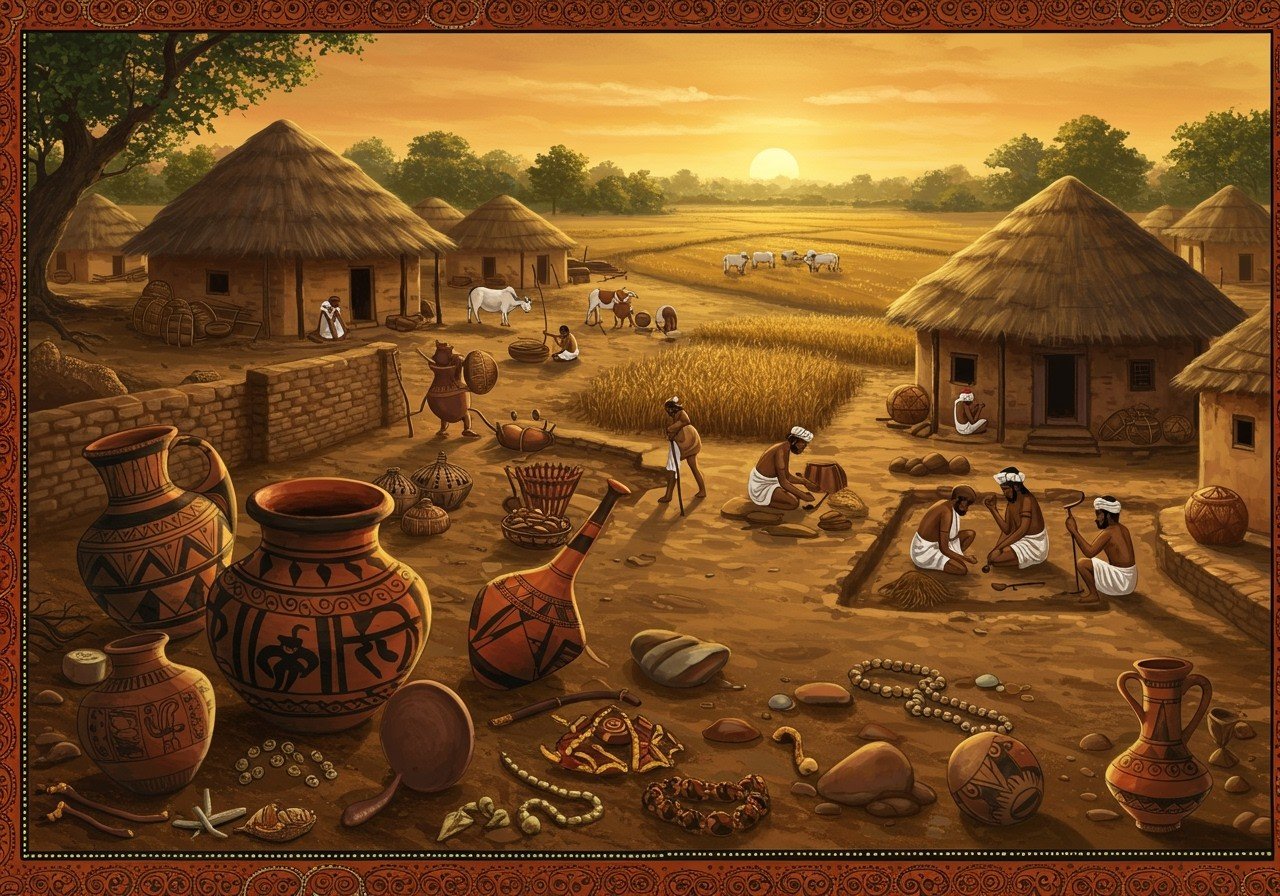
The Jorwe Culture represents a significant chapter in ancient Indian history, specifically within the Deccan region. This blog post offers a comprehensive exploration of the Jorwe Culture, drawing insights from NCERT and UPSC study materials. Our readers interested in cultural heritage will gain a thorough understanding of this prehistoric society, which thrived from approximately 1400 to 700 BCE.
Origins and Historical Context
Geographical Spread and Timeline
The Jorwe Culture predominantly flourished in Maharashtra, excluding the coastal region and Vidarbha, and the Deccan Plateau. It prospered during the Chalcolithic age to the early Iron Age, roughly from 1400 to 700 BCE. River valleys, particularly the Godavari, played a vital role in shaping Jorwe settlements.
Key Archaeological Sites
Significant archaeological sites associated with the Jorwe Culture include Jorwe (the namesake site on the Pravara river in Ahmednagar), Nevasa, Daimabad, and Inamgaon. These locations provide substantial evidence about the culture. Archaeologists employ methods like radiocarbon dating to analyze these sites and artifacts. The interaction between the Jorwe Culture and contemporary cultures is also a subject of scholarly interest. For more on Sun Temples, explore our guides: Sun Temple Modhera: Your Complete Guide and Konark vs Modhera: A Sun Temple Comparison.
Archaeological Discoveries
Pottery and Tools
The distinctive red and orange pottery is a hallmark of the Jorwe Culture. A variety of tools and implements, including stone and metal artifacts, have been unearthed, shedding light on their technological advancements.
Agricultural Practices
Evidence reveals that the Jorwe people cultivated crops like barley and wheat, indicating established agricultural practices. This agricultural proficiency contributed significantly to their settled lifestyle and societal development.
Burial Practices
Burial practices within the Jorwe Culture encompassed various types of graves and funerary goods. Megalithic structures offer crucial insights into their societal organization and beliefs. Notable excavations by archaeologists like H.D. Sankalia and M.K. Dhavalikar have proven instrumental in understanding these practices.
Societal Structure and Daily Life
Social Hierarchy
Evidence suggests a social hierarchy within the Jorwe communities, possibly with chiefs or leaders. The presence of specialized crafts and varying sizes of dwellings further supports this theory.
Settlement Layout
Typical Jorwe settlements featured residential and communal structures, often made of mud-brick. The layout suggests a planned and organized community life.
Economic Activities
Economic activities included farming, hunting, and trade. Artisans and craftsmen produced goods for daily use and exchange, indicating a degree of economic specialization.
Religious Practices
Religious practices and rituals held significance in Jorwe society, although specific details remain elusive. Evidence of potential sacred sites or communal spaces suggests organized spiritual practices.
Diet and Daily Life
Archaeological findings offer glimpses into the diet and daily routines of the Jorwe people. Analysis of plant and animal remains helps reconstruct their subsistence strategies.
Cultural Practices and Beliefs
Artifacts and Religious Practices
Artifacts such as figurines and ceremonial objects provide clues about religious practices. Pottery designs and motifs offer further insights into their belief systems. Explore similar spiritual traditions with authentic ritual items from Poojn.in: Laddoo Gopal and Radha Krishna Murti.
Festivals and Mythology
While direct evidence is limited, the presence of communal spaces suggests the possibility of festivals or gatherings. Mythology and oral traditions likely played a role in their social cohesion and belief systems.
Burial Customs
Burial customs, including the presence of grave goods and varied burial types, offer valuable insights into Jorwe beliefs about the afterlife and the spiritual world.
Conclusion
The Jorwe Culture stands as a captivating testament to India’s rich past. Their organized settlements, distinctive pottery, and advanced agricultural practices reveal a sophisticated society. Studying their archaeological sites and artifacts provides valuable glimpses into their daily lives, social structures, and beliefs. The Jorwe Culture connects us to our heritage and underscores the depth and complexity of India’s ancient history.
How Poojn.in Supports Your Spiritual Journey
Poojn.in offers a wide selection of products to support your spiritual journey. While specific Jorwe Culture artifacts are historical items, we provide authentic products for similar spiritual practices today:
- Pure Copper Vessels: Similar to those found in Jorwe excavations, we offer ritual-grade copper items for sacred ceremonies. Copper is believed to enhance the purity and energy of rituals.
- Traditional Clay Pots: Handcrafted earthenware connects you to the pottery traditions of ancient cultures. Clay pots are ideal for storing sacred water or preparing offerings.
- Puja Thalis: Complete sets for performing rituals, made with traditional materials. Our thalis include all the essential items for a fulfilling puja experience.
- Sacred Herbs and Incense: Natural ingredients for ritual offerings. We offer a variety of high-quality herbs and incense to enhance your spiritual practices.
- Ritual Accessories: Authentic items made following traditional specifications. Discover diyas, bells, and other items to enrich your rituals.
Visit Poojn.in to explore our collection of ritual items that help preserve and practice ancient Indian spiritual traditions. Our products are verified for authenticity and ritual compliance by religious experts.


